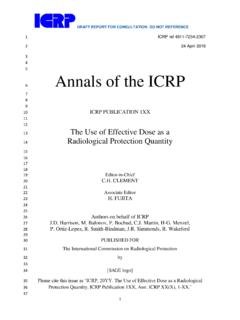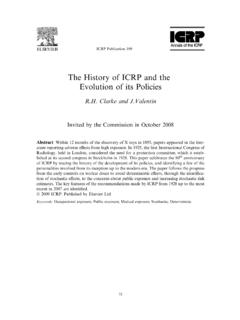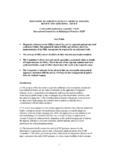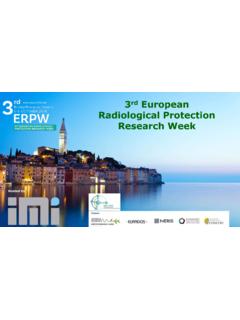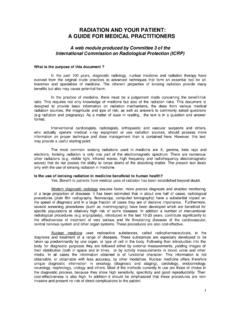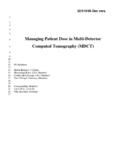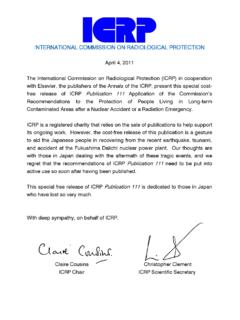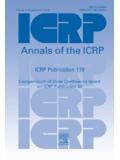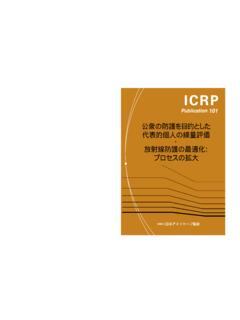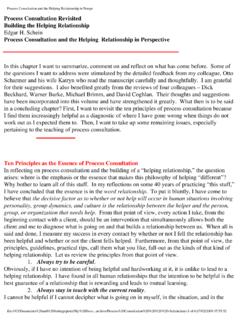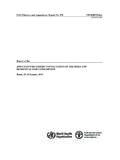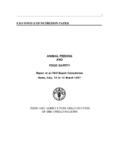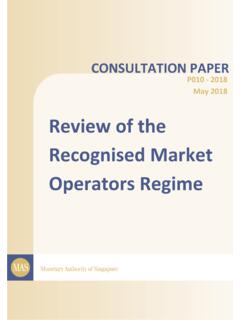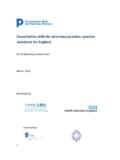Transcription of DRAFT REPORT FOR CONSULTATION - ICRP
1 DRAFT REPORT FOR CONSULTATION ICRP ref 4828-2081-0510 1 2012 February 23 2 3 4 5 6 7 Annals of the ICRP 8 9 ICRP PUBLICATION XXX 10 11 12 occupational Intakes of Radionuclides 13 Part 1 14 15 16 17 18 19 20 21 22 23 24 25 DRAFT REPORT FOR CONSULTATION 2 26 occupational Intakes of Radionuclides 27 Part 1 28 29 30 ICRP Publication XXX 31 32 Approved by the Commission in XXX 33 34 Abstract- This REPORT is the first in a series of documents replacing the Publication 30 35 series and Publication 68 to provide revised dose coefficients for occupational intakes of 36 radionuclides (OIR) by inhalation and ingestion.
2 The revised dose coefficients have been 37 calculated using the Publication 100 Human Alimentary Tract Model (HATM) and a 38 revision of the Publication 66 Human Respiratory Tract Model (HRTM) which takes 39 account of more recent data. In addition, information has been provided on absorption to 40 blood following inhalation and ingestion of different chemical forms of elements and 41 their radioisotopes, in those cases for which it is judged that the data are sufficient to 42 make specific recommendations.
3 Revisions have been made to many models for the 43 systemic biokinetics of radionuclides absorbed to blood, making them more 44 physiologically realistic representations of uptake and retention in organs and tissues and 45 of excretion. 46 The reports in this series provide data for the interpretation of bioassay measurements as 47 well as giving dose coefficients, replacing Publications 54 and 78. In assessing bioassay 48 data such as measurements of whole-body or organ content or urinary excretion, 49 assumptions have to be made about the exposure scenario, including the pattern and 50 mode of radionuclide intake , physical and chemical characteristics of the material 51 involved and the elapsed time between the exposure(s) and measurement.
4 This REPORT 52 provides some guidance on monitoring programmes and data interpretation. 53 54 Keywords: occupational exposure, Internal Dose Assessment, Biokinetic and Dosimetric 55 models, Bioassays interpretation. 56 57 DRAFT REPORT FOR CONSULTATION 3 CONTENTS 58 PREFACE 5 59 GLOSSARY 8 60 1 INTRODUCTION 25 61 Purpose of this REPORT series 25 62 Protection quantities and dose coefficients in this REPORT series 26 63 Previous reports on occupational intakes of radionuclides 28 64 Changes in Publication 103 (ICRP, 2007)
5 That affect the calculation of 65 equivalent and effective dose 29 66 Biokinetic models implemented in this REPORT 31 67 Dosimetry implemented in this REPORT 34 68 Interpretation of bioassay data 36 69 Structure of the REPORT 37 70 2 CONTROL OF occupational EXPOSURES TO RADIONUCLIDES71 39 72 Limits, Constraints, Reference Levels and Investigation Levels 39 73 Control of Worker Doses 40 74 Objectives of Monitoring 41 75 Categories of Individual Monitoring Programme 42 76 Needs for Individual Monitoring 43 77 Female Workers.
6 Pregnancy and breast-feeding 44 78 3 BIOKINETIC AND DOSIMETRIC MODELS 46 79 Introduction 46 80 Revised Human Respiratory Tract Model (HRTM) 48 81 Human Alimentary Tract Model (HATM) 78 82 Intact Skin and Wounds 84 83 Biokinetic Models for Systemic Radionuclides 87 84 Medical Intervention 97 85 Methodology for dose calculations 97 86 4 METHODS OF INDIVIDUAL AND WORKPLACE MONITORING 103 87 Introduction 103 88 Body Activity Measurements (In Vivo Measurements) 103 89 Analysis of Excreta and Other Biological Materials 104 90 Exposure Monitoring of the Workplace 105 91 5 MONITORING PROGRAMMES 107 92 Introduction 107 93 General Principles for the Design of Individual Monitoring Programmes 107 94 Categories of Monitoring Programmes 108 95 Derived Investigation Levels 111 96 Record Keeping and Reporting 112 97 Quality Management System 112 98 6 GENERAL ASPECTS OF RETROSPECTIVE DOSE ASSESSMENT 114 99 Introduction 114 100 DRAFT REPORT FOR CONSULTATION 4 Types of Analysis 116 101
7 Understanding Exposure Situations 117 102 Measurements 121 103 Uncertainties in Internal Dose Assessment Based on Bioassay 124 104 7 DATA PROVIDED FOR ELEMENTS AND RADIOISOTOPES 136 105 Introduction 136 106 Dose coefficients 137 107 Interpretation of Individual Monitoring Data 137 108 Quality Assurance 139 109 REFERENCES 140 110 111 DRAFT REPORT FOR CONSULTATION 5 PREFACE 112 The system of protection recommended by the International Commission on 113 Radiological Protection is the basis for standards and working practices throughout 114 the world (ICRP, 1991, 2007; IAEA 1996a).
8 Fundamental to the application of ICRP 115 recommendations are the protection quantities defined by ICRP, equivalent dose and 116 effective dose. While the definition of these quantities remains unchanged in the most 117 recent recommendations (ICRP, 2007), there have been important changes that affect 118 the values calculated per unit radiation exposure. Committee 2 of ICRP is responsible 119 for the provision of these reference dose coefficients for the assessment of internal 120 and external radiation exposure, calculated using reference biokinetic and dosimetric 121 models, and reference data for workers and members of the public.
9 Following from 122 the 2007 Recommendations, Committee 2 and its Task Groups are engaged in a 123 substantial programme of work to provide new dose coefficients for various 124 circumstances of radiation exposure. 125 The 2007 Recommendations (Publication 103, ICRP, 2007) introduced changes to the 126 radiation weighting factors used in the calculation of equivalent dose to organs and 127 tissues and also changes to the tissue weighting factors used in the calculation of 128 effective dose.
10 In addition, an important development was the adoption of reference 129 anatomical computational phantoms (that is, models of the human body based on 130 medical imaging data), in place of the composite mathematical models that have been 131 used for all previous calculations of organ doses. This process has commenced with 132 the adoption of reference male and female adult models (ICRP, 2009) and will be 133 continued with the adoption of paediatric phantoms. Publication 103 also clarified the 134 need for separate calculation of equivalent dose to males and females and sex-135 averaging in the calculation of effective dose (ICRP, 2007).
